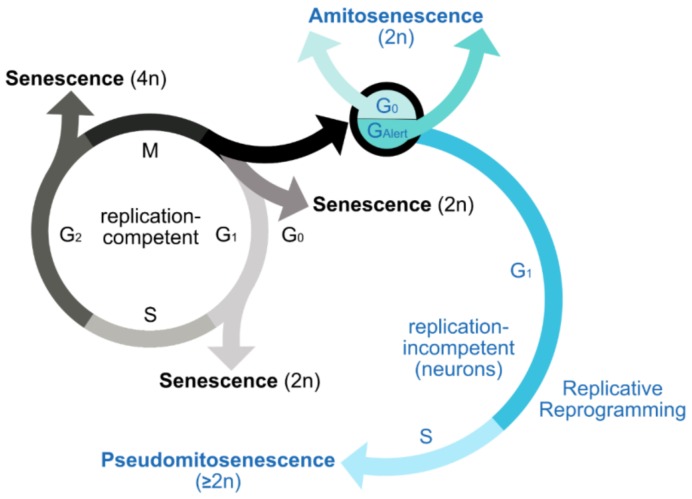Figure 1.
Senescence-like phenotype in neurons and its putative association with cell cycle dynamics. In replicative tissues, senescence is commonly expected to eventuate in G0/G1; however, it also occurs in the G2 phase. According to recent developments in neuroscience, terminally differentiated neurons might also adopt a senescence-like state out of a quiescent G0 phase, e.g., consecutive to cellular stress imposed by DNA and telomere damage, a process termed here as ‘amitosenescence’. Whether neurons can further perform an adaptive G0–GAlert transition, in analogy to the recent discovery of such an ‘alert state’ in quiescent stem cells, in order to boost respective stress responses, is an interesting, yet unaddressed question. Beyond such novel insight into the conditions of senescence, the long-standing dogma of neurons being ultimately postmitotic has equally been changed. Thus, the reinduction of unscheduled cell cycle activity in terminally differentiated neurons appears broadly established, as illustrated for several neurodegenerative disorders. Though abortive in most instances, such replicative reprogramming might provoke a senescence-inductive DDR due to DNA content variations resulting from a reinitiated S phase. Such a process, termed pseudomitosenescence, might confer additional, yet unidentified cellular and molecular signatures to the process of senescence in neurons. Whether a putative GAlert adaption, which primes quiescent stem cells for cell cycle re-entry, might also prime neurons to complete the G0 exit and trigger the reinduction of unscheduled cell cycle activity, is a similarly tempting issue. Grey colors refer to replication-competent cells; blue colors are related to replication-incompetent cells, particularly neurons.

